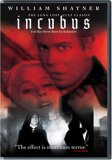One of the great oddities of film from the 1960s (or, indeed, ever) is a modest little horror film by the name of Incubus. Emerging in 1965, it was shot in Big Sur, and tells the mythic tale of a young soldier returning home to become the target of a female demon. His innate goodness, however, winds up seducing the demon instead, and the titular male demon vows revenge, specifically targeting the soldier’s blind sister. This is already a somewhat odd tale for a mid-sixties American horror film, and the fairy-tale setting is even more unusual. But the real oddities are yet to come. The lead is played by a William Shatner (in his last film before Star Trek). And all of the dialogue is in the artificial language Esperanto.
Why Esperanto? Why indeed. Phil Hardy cites director Leslie Stevens (the creator of The Outer Limits) as describing the language as “at once imaginary and universal, out of time and space.” There is no doubt that film’s effect is precisely that. The world the viewer moves through is completely alien, even if the settings themselves (forests, seasides) are very familiar. When I called the film a fairy tale, I did so advisedly. This is one of the most fairy tale-like horror films ever made (and horror partakes of that form of storytelling more than just about any other genre). This is thus a tale of no place and every place, of no time and every time. It takes very little time for the viewer to get past the strange spectacle of Shatner spouting Esperanto (doing so very naturally, I might add) and be swallowed up by this strange world.
Aiding immeasurably is the wonderful cinematography of Conrad L. Hall. The moody, stark black-and-white is in a style with which audiences might well be familiar, but again, not from other genre offerings of the period, with the possible exception of Mario Bava’s Black Sunday. No, the sprit that is summoned here is that of Ingmar Bergman. Shatner’s farm might as well be just over the hill from the Max Von Sydow’s home in Hour of the Wolf. Between the stark beauty of the cinematography, the making-strange effect of the subtitled language (an effect that, unique among films, would be experience everywhere in the world), and the moody angst of the protagonists make this a movie that would seem to claim not California as its home, but Sweden. I can’t really emphasize these qualities of the film too much, since this project so easily could have been utterly ridiculous, instead of the poetically disorienting experience that it is.
The DVD was released in 2001, but miraculously is still in stock at Amazon. It’s quite the gem of a package, not only presenting a lovely print of a long-lost film, but also boasting plenty of extras in the form of two commentary tracks (one of which is by Shatner) and interviews with the surviving crew (Hall, producer Anthony Taylor, and the uncredited William Fraker, who also worked on the cinematography).
I could say more, but I won’t. This is the sort of film one has to fall into, and work with. But the rewards are considerable.


